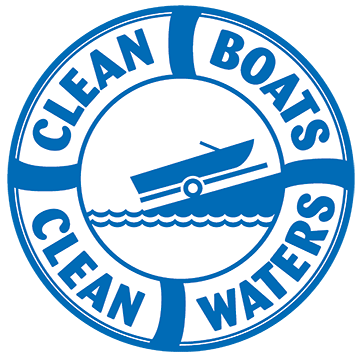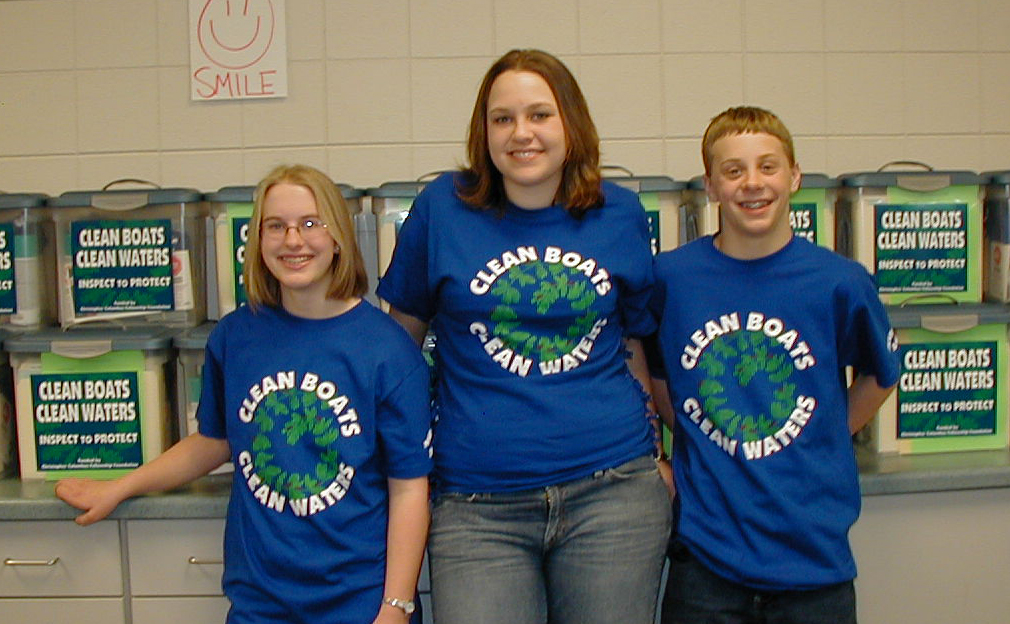 How to Get Involved in CBCW
How to Get Involved in CBCW
 In 2003, a group of young students from northern Wisconsin researched the impact tourism had on their town, Minocqua, and the devastating impacts aquatic invasive species (AIS) might have on the surrounding lakes. As young student activists, they proposed an action plan to prevent the spread of an aquatic invasive plant, Eurasian watermilfoil. The Christopher Columbus Fellowship Foundation, recognizing innovative ideas from young people, awarded this group $25,000 to develop and market an educational tool kit for boaters. The Milfoil Masters project produced and delivered 150 tool kits to twenty-five counties across Wisconsin. This successful project created an awareness of not only AIS, but also the prevention steps each boater needs to take when they leave a waterbody.
In 2003, a group of young students from northern Wisconsin researched the impact tourism had on their town, Minocqua, and the devastating impacts aquatic invasive species (AIS) might have on the surrounding lakes. As young student activists, they proposed an action plan to prevent the spread of an aquatic invasive plant, Eurasian watermilfoil. The Christopher Columbus Fellowship Foundation, recognizing innovative ideas from young people, awarded this group $25,000 to develop and market an educational tool kit for boaters. The Milfoil Masters project produced and delivered 150 tool kits to twenty-five counties across Wisconsin. This successful project created an awareness of not only AIS, but also the prevention steps each boater needs to take when they leave a waterbody.
The Clean Boats, Clean Waters (CBCW) program grew out of the successful Milfoil Masters project. New resource tool kits, t-shirts and volunteer handbooks were designed to guide communities in developing a volunteer watercraft inspection team. The Wisconsin Lakes Partnership (DNR, UW-Extension Lakes Program and Wisconsin Lakes) assisted in this effort with a series of statewide workshops to deliver the CBCW materials. These workshops were strategically placed in lake intensive areas of the state where invading aquatic species were most likely to take a foothold.
Since 2004 when the CBCW program was initiated, hundreds of workshops have been held and thousands of folks in over fifty counties have been trained as watercraft inspectors. Lake residents, county board members, tribal community members, representatives from county park and forest programs, boat marina operators and realtors have attended the workshops to learn how AIS threaten Wisconsin waters. They also received instructions on how to organize a watercraft inspection program, how to approach boaters, perform boat/trailer checks, record pertinent data and report suspect specimens.
With the guidance of a CBCW handbook and a resource kit full of aquatic invasive species information, trained inspectors are the frontline defense against AIS. On weekends and busy holidays, teams of watercraft inspectors across the state educate boaters on how and where AIS are most likely to hitch a ride and how to perform a watercraft inspection. During watercraft inspections, inspectors engage boaters in conversation about the AIS prevention steps and keep a record of how many people they talk with. They report this information to a statewide database that tabulates both paid and volunteer watercraft inspector data.
Back to top
The Clean Boats, Clean Waters program, sponsored by the Wisconsin Lakes Partnership, offers a series of training workshops across the state each spring and summer. These workshops provide an opportunity to learn how and why educational awareness is so important in preventing the spread of AIS.
During the Clean Boats, Clean Waters workshop, resource professionals provide an overview of aquatic invasive species, such as Eurasian watermilfoil and zebra mussels, and instructions on how to organize an effective watercraft inspection program. Participants also practice having an effective conversation with boaters at the landing through role-playing. There is no cost to attend the workshop, and interested participants can purchase the Clean Boats, Clean Waters Watercraft Inspection manual and a kit (containing educational publications, two Clean Boats t-shirts, an inspection apron, and more) for $25.00.
To register for a workshop, contact the resource person listed in the workshop description on the CBCW calendar. Additional workshops may be added in specific areas if there is public interest. Please contact the CBCW Training coordinator or AIS staff member listed for your area about workshop availability during the summer (see header below for more info).
We are fortunate to have many partners from a wide variety of agencies and organizations who work on aquatic invasive species issues and coordinate CBCW efforts in their areas. Many of them are funded through DNR grants for AIS prevention and planning and are known as AIS Coordinators. Among their many roles is to help support and train local CBCW watercraft inspectors. These folks are wonderful resources! Please let them help you as you begin to learn or refresh your understanding of the CBCW program.
Find out who is working on AIS issues near you -
click here
Mission: The Wisconsin monitoring network functions as a comprehensive stakeholder collaboration designed to improve the effectiveness of monitoring efforts by providing communications, resources and recognition in order to build and maintain the dynamic picture of our natural resources.
The Citizen Lake Monitoring Network (CLMN) creates a bond between 1000+ citizen volunteers statewide and the Wisconsin Lakes Partnership. Our goals are to collect high quality data, educate and empower volunteers, and share this information.
CLMN staff provide volunteers with the necessary equipment and training to conduct these monitoring activities. Volunteers provide their time, expertise, energy, and a willingness to share information with their fellow lake residents or other lake users. The information gathered by these monitoring programs is used by Wisconsin Department of Natural Resources and university biologists and researchers, UW-Extension, and other interested individuals.
Wisconsin’s rivers are vulnerable to invasion by a number of invasive species from Eurasian milfoil to Japanese knotweed. The key to successfully protecting your river is detecting invasives early when it is still possible to isolate or eradicate the infestation. The longer we wait to find them and fight them, the more money and time it will take. Volunteers like you are invaluable for early detection. Over 200 individuals have been trained. Join us!
Why You Should Join Project RED?
- Easy, Fun and Flexible Protocols to Identify Species of Concern
- Great Opportunity to Engage New Members/Volunteers
- Educate Local Landowners About Invasive Species
- Online Data Management Tools Managed by the Wisconsin Department of Natural Resources
- Species Verification by Professionals
- Eradication and Containment Technical Support
- It's Free
The DNR and University of Wisconsin-Extension (UWEX), along with hundreds of citizen cooperators, have been introducing natural insect enemies of purple loosestrife, from its home in Europe, to infested wetlands in the state since 1994. Careful research has shown that these insects are dependent on purple loosestrife and are not a threat to other plants. Insect releases monitored in Wisconsin and elsewhere have shown that these insects can effectively decrease purple loosestrife's size and seed output, thus letting native plants reduce its numbers naturally through enhanced competition.
Mission: Protecting in Partnership Our Legacy of Lakes
Role: Enhance skills and broaden capabilities of people in our lake communities, champion effective and communicative collaboration, and foster responsive and useful networks that support lake citizens.
This unique event brings together citizen scientists, businesses, and lake, river and wetland professionals to interact, learn, share and engage with one another to ensure a healthy future for our waters. The Wisconsin Lakes Partnership includes anyone interested in preserving and protecting our water resources, and begins with three main components (and organizations): 1) Science (Wisconsin Department of Natural Resources), 2) Education/Outreach (University of Wisconsin) and 3) Citizens (Wisconsin Lakes).
Water Action Volunteers (WAV) is a statewide program for Wisconsin citizens who want to learn about and improve the quality of Wisconsin’s streams and rivers.
Back to top
For more information contact
Erin McFarlane, Statewide CBCW Educator
Or go to
The Wisconsin Department of Natural Resources site
